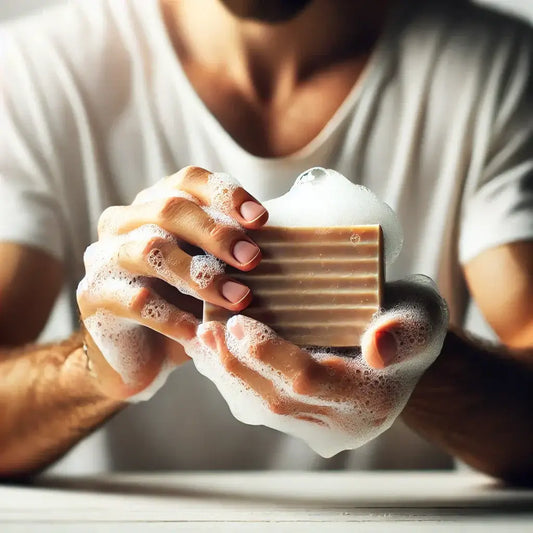
Lathering Through Time: The History of Men’s Natural Soap from Ancient Times to Today
Share
When you reach for your favorite bar of men’s natural soap, have you ever wondered about its origins? Soap is something we often take for granted, but it has a rich and storied past. From the ancient Babylonians to today’s artisanal soap makers, the journey of soap is a tale of innovation, tradition, and a bit of alchemy. In this deep dive, we’ll explore "The History of Men’s Natural Soap: From Ancient Times to Today," tracing the evolution of this everyday essential and highlighting its enduring significance.
Ancient Beginnings: The Birth of Soap
Early Soap Makers
Long before the advent of modern chemistry, ancient civilizations were already crafting rudimentary soaps using the materials they had on hand.
The Babylonians
- Earliest Evidence: The earliest known soap recipe dates back to around 2800 BC, found in ancient Babylon. These early soap makers combined fats with wood ash to create a basic form of soap.
- Uses: Initially, soap was used primarily for cleaning wool and cotton in textile manufacturing, rather than for personal hygiene.
The Egyptians
- Innovations: By 1500 BC, the Egyptians had developed a more advanced form of soap by mixing animal and vegetable oils with alkaline salts.
- Hygiene Practices: Soap became integral to Egyptian daily life, used not just for laundering clothes but also for personal cleanliness and treating skin diseases.
Soap in the Ancient World
As civilizations expanded, so did the knowledge and use of soap.
The Romans
- Public Baths: The Romans were known for their elaborate public baths, where soap made from goat’s tallow and beech tree ashes played a key role in their extensive bathing rituals.
- Widespread Use: Soap production became more widespread, and its use extended beyond hygiene to medical treatments.
Understanding Soap Labels: What to Look For in Men’s Natural Soaps
Even in ancient times, the quality and ingredients of soap varied. Understanding what goes into your soap was as important then as it is now.
Medieval to Modern: The Evolution Continues
The Middle Ages
Soap making evolved significantly during the Middle Ages, driven by both necessity and innovation.
The Arabs
- Refinement: The Arabs refined soap making techniques, introducing the use of lye derived from alkali plants and adding fragrances to the soap.
- Spread of Knowledge: This knowledge spread to Europe through trade and the Crusades, laying the groundwork for the soap industry in Europe.
European Advancements
- Guilds: By the 12th century, soap making guilds were established in Europe, particularly in Spain and Italy, where olive oil was a key ingredient.
- Hard vs. Soft Soap: The distinction between hard (bar) and soft (liquid) soap emerged, influenced by the availability of raw materials and local traditions.
The Renaissance and Beyond
The Renaissance brought about significant advancements in science and industry, which also impacted soap making.
Scientific Discoveries
- Chemical Understanding: Greater understanding of chemistry allowed for more precise and consistent soap production.
- Improved Ingredients: Innovations such as the use of palm oil and coconut oil improved the quality and variety of soap available.
Industrial Revolution
- Mass Production: The Industrial Revolution brought soap from a handcrafted luxury to a mass-produced commodity, making it more accessible to the general public.
- Advertising: Brands began to emerge, using advertising to highlight the benefits of their particular soap formulations.
Nostalgic Skin Co: A Modern Take on Tradition
Nostalgic Skin Co embraces the rich history of soap making while incorporating modern science and sustainable practices.
Craftsmanship Meets Innovation
- Artisanal Techniques: Blending traditional methods with contemporary knowledge, Nostalgic Skin Co ensures each bar of men’s soap is crafted with care.
- Quality Ingredients: Using natural oils, butters, and essential oils, they create soaps that honor the past while meeting today’s skincare needs.
The Modern Era: Natural Soap Renaissance
The Return to Natural
In recent years, there has been a significant shift back to natural, artisanal soaps.
Consumer Awareness
- Ingredient Transparency: Modern consumers are more informed and seek transparency about what goes into their personal care products.
- Health and Environment: Concerns about synthetic chemicals and their impact on health and the environment have driven the demand for natural alternatives.
Trends in Men’s Natural Soap
Men’s grooming has seen a resurgence in natural products, with a focus on both functionality and sustainability.
Specialty Soaps
- Beard Care: Soaps formulated specifically for beard maintenance, combining cleansing with conditioning.
- Exfoliating Bars: Natural exfoliants like oatmeal and coffee grounds are popular for their skin-smoothing benefits.
Understanding Soap Labels: What to Look For in Men’s Natural Soaps
Knowing how to read and understand soap labels is crucial in choosing the right product.
Key Ingredients
- Plant-Based Oils: Look for oils like coconut, olive, and shea butter.
- Natural Additives: Ingredients like charcoal, clay, and essential oils offer added benefits.
- Avoid Synthetics: Steer clear of synthetic fragrances, dyes, and preservatives.
Nostalgic Skin Co: Leading the Way
Nostalgic Skin Co stands out in the modern market by combining a respect for historical methods with a commitment to quality and sustainability.
Sustainable Practices
- Ethical Sourcing: Ingredients are sourced responsibly, ensuring minimal environmental impact.
- Eco-Friendly Packaging: Packaging is designed to be sustainable, reducing waste and supporting a circular economy.
FAQs
Why did ancient civilizations use soap?
Ancient civilizations used soap primarily for cleaning textiles and for personal hygiene as their understanding of health and cleanliness evolved.
What makes natural soap different from synthetic soap?
Natural soap is made from natural ingredients like plant oils and lye, while synthetic soap often contains artificial detergents, fragrances, and preservatives.
How can I ensure a soap is truly natural?
Check the ingredient list for recognizable natural components and look for certifications from reputable organizations.
Why is there a resurgence in natural soap?
Increased consumer awareness about health and environmental impacts has driven a preference for natural, sustainable products.
What should I look for in a men’s natural soap?
Look for quality ingredients such as plant-based oils and natural additives, and avoid synthetic chemicals.
Conclusion
From its ancient roots to its modern-day resurgence, the history of men’s natural soap is a fascinating journey through time. Each era brought its innovations and traditions, culminating in the high-quality, artisanal soaps we see today. Brands like Nostalgic Skin Co honor this rich history while embracing sustainable, modern practices, ensuring that every bar of soap not only cleanses but also cares for your skin and the environment. So, next time you lather up, remember that you're part of a story that spans millennia, connecting you to the ingenuity and wisdom of the past.






